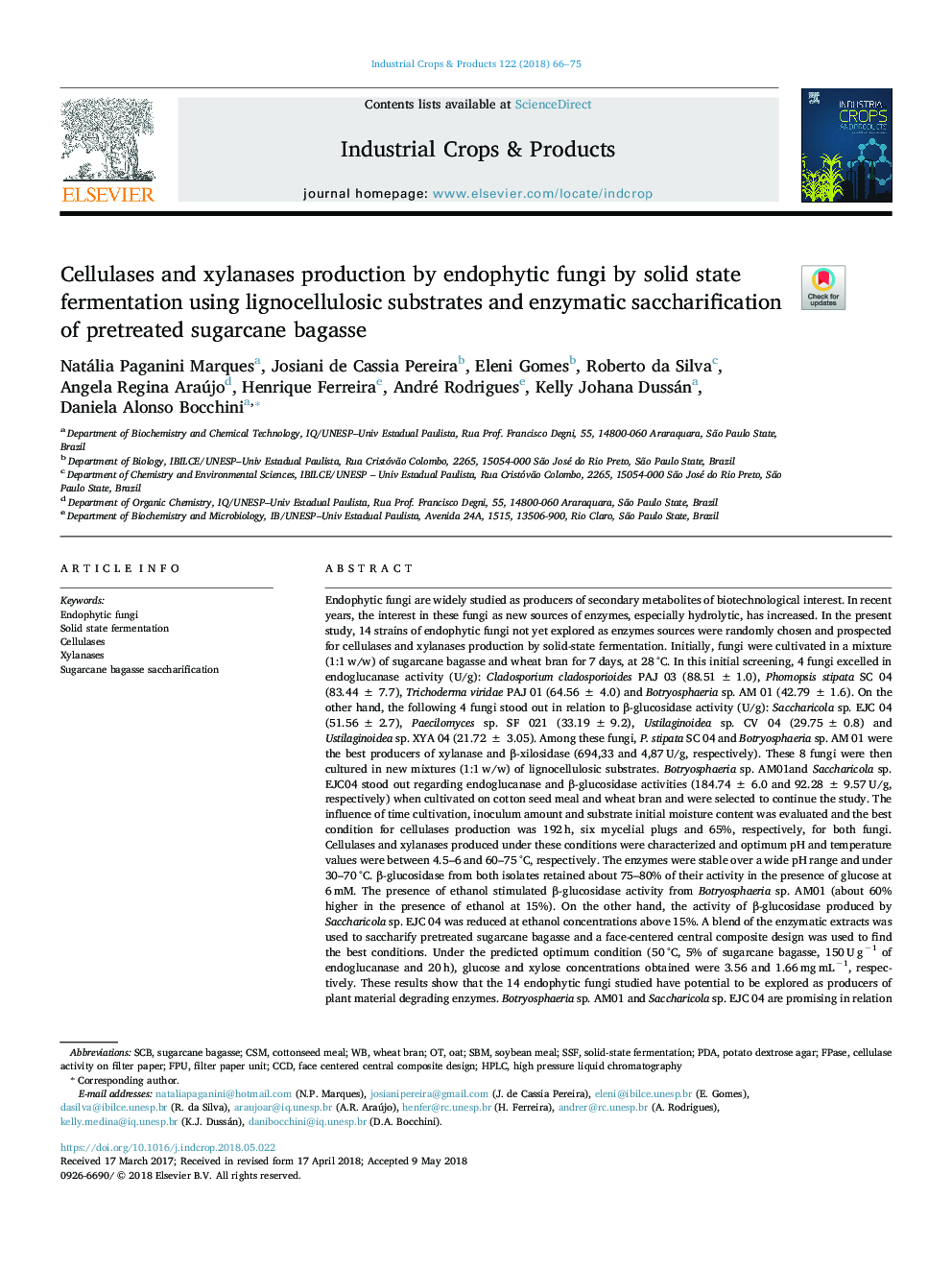| Article ID | Journal | Published Year | Pages | File Type |
|---|---|---|---|---|
| 8879755 | Industrial Crops and Products | 2018 | 10 Pages |
Abstract
Endophytic fungi are widely studied as producers of secondary metabolites of biotechnological interest. In recent years, the interest in these fungi as new sources of enzymes, especially hydrolytic, has increased. In the present study, 14 strains of endophytic fungi not yet explored as enzymes sources were randomly chosen and prospected for cellulases and xylanases production by solid-state fermentation. Initially, fungi were cultivated in a mixture (1:1â¯w/w) of sugarcane bagasse and wheat bran for 7â¯days, at 28â¯Â°C. In this initial screening, 4 fungi excelled in endoglucanase activity (U/g): Cladosporium cladosporioides PAJ 03 (88.51â¯Â±â¯1.0), Phomopsis stipata SC 04 (83.44â¯Â±â¯7.7), Trichoderma viridae PAJ 01 (64.56â¯Â±â¯4.0) and Botryosphaeria sp. AM 01 (42.79â¯Â±â¯1.6). On the other hand, the following 4 fungi stood out in relation to β-glucosidase activity (U/g): Saccharicola sp. EJC 04 (51.56â¯Â±â¯2.7), Paecilomyces sp. SF 021 (33.19â¯Â±â¯9.2), Ustilaginoidea sp. CV 04 (29.75â¯Â±â¯0.8) and Ustilaginoidea sp. XYA 04 (21.72â¯Â±â¯3.05). Among these fungi, P. stipata SC 04 and Botryosphaeria sp. AM 01 were the best producers of xylanase and β-xilosidase (694,33 and 4,87â¯U/g, respectively). These 8 fungi were then cultured in new mixtures (1:1â¯w/w) of lignocellulosic substrates. Botryosphaeria sp. AM01and Saccharicola sp. EJC04 stood out regarding endoglucanase and β-glucosidase activities (184.74â¯Â±â¯6.0 and 92.28â¯Â±â¯9.57â¯U/g, respectively) when cultivated on cotton seed meal and wheat bran and were selected to continue the study. The influence of time cultivation, inoculum amount and substrate initial moisture content was evaluated and the best condition for cellulases production was 192â¯h, six mycelial plugs and 65%, respectively, for both fungi. Cellulases and xylanases produced under these conditions were characterized and optimum pH and temperature values were between 4.5-6 and 60-75â¯Â°C, respectively. The enzymes were stable over a wide pH range and under 30-70â¯Â°C. β-glucosidase from both isolates retained about 75-80% of their activity in the presence of glucose at 6â¯mM. The presence of ethanol stimulated β-glucosidase activity from Botryosphaeria sp. AM01 (about 60% higher in the presence of ethanol at 15%). On the other hand, the activity of β-glucosidase produced by Saccharicola sp. EJC 04 was reduced at ethanol concentrations above 15%. A blend of the enzymatic extracts was used to saccharify pretreated sugarcane bagasse and a face-centered central composite design was used to find the best conditions. Under the predicted optimum condition (50â¯Â°C, 5% of sugarcane bagasse, 150â¯Uâ¯gâ1 of endoglucanase and 20â¯h), glucose and xylose concentrations obtained were 3.56 and 1.66â¯mgâ¯mLâ1, respectively. These results show that the 14 endophytic fungi studied have potential to be explored as producers of plant material degrading enzymes. Botryosphaeria sp. AM01 and Saccharicola sp. EJC 04 are promising in relation to the production of cellulases and xylanases and their enzymatic extracts have potential for application in pre-treated sugarcane bagasse saccharification processes.
Keywords
Related Topics
Life Sciences
Agricultural and Biological Sciences
Agronomy and Crop Science
Authors
Natália Paganini Marques, Josiani de Cassia Pereira, Eleni Gomes, Roberto da Silva, Angela Regina Araújo, Henrique Ferreira, André Rodrigues, Kelly Johana Dussán, Daniela Alonso Bocchini,
